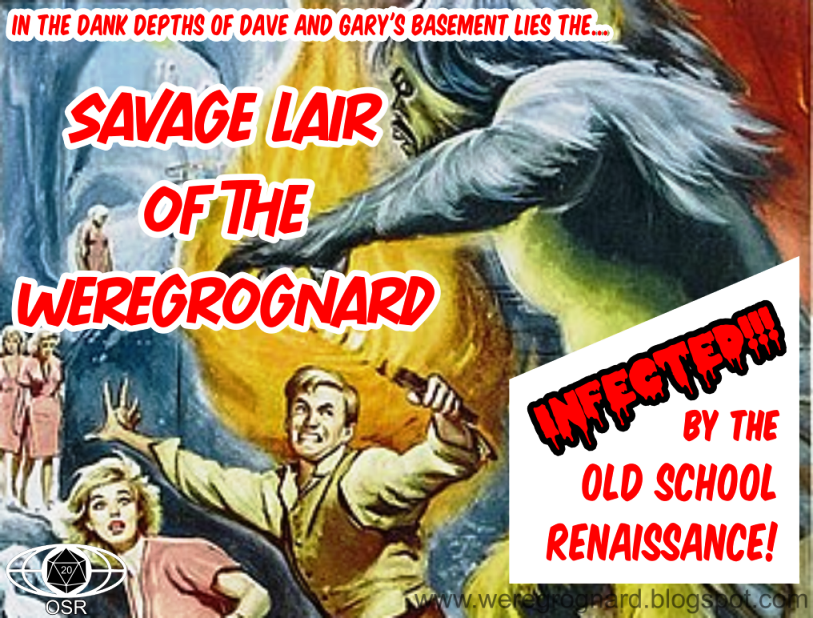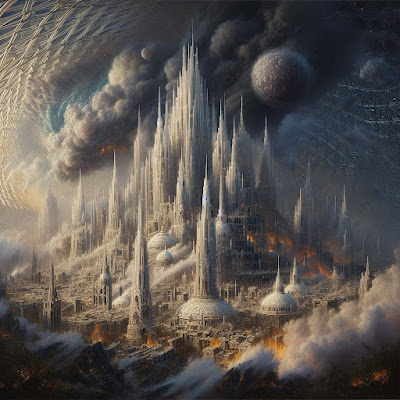Area 29: Quicksilver Pools
After a brief journey through a tunnel of flashing light, the PCs awaken inside shallow pools of quicksilver. These lie on a floating island in an infinite “sea” of twinkling lights within clouds of prismatic phlogiston. Some of the closest lights appear to be polyhedral shapes that float in the ethereal soup. Other floating islands, large and small, can be seen in all directions, but the eye gravitates towards an immense, chaotic Maelstrom in the distance.
The PCs bodies emerge from the quicksilver as versions of themselves that glow with an inner light. Any magic items they posses also have glowing versions, but no other material possessions make the trek (which could be somewhat of an embarrassment for those that appear unclothed.) Some of the quicksilver clings behind them, and tapers into an insubstantial cord that connects them to their respective pools. They also feel weightless.
A glowing image of MYTHRAS, in the guise of Dr. Bamutu, waits patiently at the center of the pools for the PCs to acclimate themselves before going into explanations about this strange realm.
No Physicality: The Astral Plane is a realm of the mind (and perhaps the soul.) Physical laws do not really apply here. As such, the characters have no Strength, Dexterity, or Constitution. Instead, these are replaced by Intelligence, Wisdom, and Charisma respectively. This may have an effect on hit rolls, armor class, and hit points, as well as tasks requiring physical prowess. Magic-users, clerics, and elves may have a clear advantage here. However, MYTHRAS reassures those who rely on their now lost, physical attributes that these can be regained if they are able to find their inner strength (see Area 30 below.)
Movement: while the characters feel weightless, the Astral Plane does have a subjective form of gravity. In order to move, characters must first decide which direction is “up” and “down,” then propel themselves by “falling” in the direction they want to go as a form of flight. This requires a Wisdom check the first time they try, but they no longer need to make checks once they succeed. Their Move is equal to their Wisdom or Intelligence score times 10 per turn, and 1/4th of that per round as normal. Characters that find their inner strength may use their Strength or Dexterity instead.
Time and healing: The characters do not need to eat, drink, or sleep here. They will also notice that they are not breathing. Their sense of time will also become distorted. MYTHRAS explains explain that they can be here indefinitely while their bodies lie in stasis, but time will continue to pass on their home plane, so they should not tarry if they can help it. He also explains that they can be hurt and even die here, since the body cannot live without the psyche. Furthermore, only curative magic can restore damage while in the Astral Plane; they cannot heal naturally.'
The Quicksilver Cords: The quicksilver cords are the PCs’ connection to the physical plane, and they can always follow this cord back to their origin pool. MYTHRAS warns them to guard this connection, for Dr. Diamante has the power to sever it, potentially trapping their psyche in the Astral Plane forever.
Once the characters have gained an understanding of this realm, MYTHRAS explains his plan: the Maelstrom is what protects Dr. Diamante from having to re-merge with the MYTHRAS AI. It allows her to remain a separate, independent entity, and subvert portions of the Wyrldbearer to her will. Alas, MYTHRAS cannot penetrate the barrier while Dr. Diamante is at her full strength, which matches his own, but the PCs can. It will be up to them to weaken her, incidentally weakening the barrier and allowing MYTHRAS to enter. He warns that once they go into the Maelstrom, they will come under direct, psychic assault - one they cannot fend off easily by mere force of arms or spells, but once they are past the barrier, she can be confronted directly.
30. The Maelstrom
The Malestrom is a dark convergence of Astral clouds, form fragments, and raw energy, created by Dr. Diamante (as a firewall) to keep MYTHRAS away. It may seem a mortal danger to go into, but PCs that try will notice that they can do so (mostly) unscathed.
Once inside, each PC will become separated by buffeting, Astral winds into their own area, where each will hear the voice of Dr. Diamante and encounter an illusory trial where she will attempt to turn them to her cause, or at least demoralize and weaken them. Here are some general ideas for each trial by character class, along with effects for success or failure. The GM should also feel free to tailor these to their players and their characters:
Trial of Might (fighters, elves, dwarves, halflings)
The PC must confront some danger related to a deep-seated fear or personal flaw while in their physically-weakened state. This may involve single combat against an equally-matched creature with full physical power, perhaps even a shadow of themselves. For example, Lawful fighters may have to protect their people, friends, or loved ones against a version of themselves that appears as a dark knight of Chaos, while Chaotic ones may have to slay a shining paladin that represents the last shred of law and goodness in themselves (which holds them back from true power.)
Success means the character finds their inner strength, and are able to use their physical attributes as normal, while failure means they remain weakened. They do not die or remain permanently damaged from any combat in the trial regardless of outcome.
Trial of Faith (clerics)
Dr. Diamante confronts the cleric with the fact that their god(s), being aspects of the MYTHRAS AI, are false and fallible; with little true power. The PC will find themselves in a situation where they no longer feel a connection to their deity, and cannot call on their power. For example, a Lawful cleric cannot help multitudes of injured or sick, or protect them from undead that cannot be turned. A Chaotic one finds themselves persecuted by an angry mob, or their army of controlled undead suddenly turns on them. Once they are overwhelmed, Dr. Diamante will offer them power if they serve her.
Characters that remain steadfast in their faith without spells or powers succeed at the trial. They regain use of their physical attributes and full allotment of spells. In addition, they can regain cast spells at a rate of one (1) turn per spell level. Those that fail remain weakened and only keep spells up to the third level of power while in the Astral Plane. All other spells are lost and they are not able to recover used spells.
Trial of Intellect (magic-users, elves)
Dr. Diamante blasts the magic-users’ mind with visions of fractal forms, non-Euclidian concepts, and quantum algorithms that seem impossible to comprehend with their pitiable, mortal minds, leaving true understanding of the multiverse tantalizingly out of reach…unless they pledge themselves to her in exchange for this knowledge.
The GM should provide the player with a simple, but still somewhat challenging puzzle such as a small maze, Sudoku puzzle, series of riddles, or the like and give them a short, real-time limit in which to solve it (no more or less than it would take the GM to solve it themselves without help. They should err on the side of mercy here.) Success allows the magic-user to choose the higher of their mental or physical attributes for physical actions while in the Astral Plane. Furthermore, they are able to re-memorize spells cast at the rate of one (1) turn per level of the spell. Failure means they cannot re-memorize spells while in the Astral Plane. In addition, their spells against Dr. Diamante will fail on a 2-in-6 chance.
Trial of Cunning and Confidence (thieves)
Dr. Diamante teases the thief character with visions of a great and valuable treasure (perhaps one known to them,) inside a courtyard. The treasure is protected by seemingly impossible obstacles:
- The wall is infinitely high and has no door. The solution is not to use their climbing ability, but to find a secret, locked door somewhere on the wall. Or perhaps, will one into existence (which surprises the Dr. Diamante before she wills a lock.)
- There is a guard (a fighter of the same level as the thief with plate mail, polearm, and sword,) patrolling outside the wall. Unfortunately, the thief is dressed in a jester’s outfit complete with loud, glowing jingle bells they cannot seem to take off, negating their ability to move with any stealth. However, if they tell the guard a joke (no matter how terrible,) he begins to laugh uncontrollably and smacks his head on the wall, falling unconscious. In his pocket is a key to the secret door.
- The courtyard inside is empty save for a treasure’s chest in the center. Approaching the chest causes it become bigger with each step the thief takes, until it is large enough for the thief to fit through the keyhole. Inside, the thief can try to move the giant pins inside to “pick” the lock as if their ability was four levels lower. Failure results in a pin slamming down on them for 3d6 damage (save against breath for half.) The thief may try again (risking injury) until all four pins are set, allowing access inside the chest via the other side of the keyhole.
Inside the chest is the same courtyard, but now the chest remains at a normal size and can be opened. Inside is the treasure, which represents the thief’s inner strength and success in the trial. With success, the thief can now employ their physical attributes as normal, and may use their stealth abilities to “backstab” Dr. Diamante during the confrontation by concealing themselves in the swirling, Astral clouds of the Maelstrom. If the thief gives up on the treasure (or refuses to try,) they will know deep down, and for all time, that they are not the greatest of thieves. Their physical abilities remain weakened, and to add insult to injury, they are wearing the glowing jester’s outfit during the confrontation with Dr. Diamante.
Any of the character may decide to pledge themselves to Dr. Diamante and thereby succeed in their trial automatically. This may lead to an awkward confrontation with any other characters that did not align themselves with her.
31. The Paradise of Tiama’at
Once through the Maelsrom, and regardless of the outcome of their individual trials, the PCs arrive in an impossibly idyllic paradise. Animals,creatures, and humanoids both mundane and mythical frolic here while paying no heed to the new visitors. Overseeing this bright, eternal garden is a large, statuesque figure which bears more than a passing resemblance to Dr. Diamante. Her skin is made of living, white opal with diamond accents. Those on her face converge into a floating crown above hair that flows constantly with the Astral winds. She gestures to the PCs with one of her many arms, some of which are dragons, and speaks to them in a voice with a plural quality that spreads through the body in wan vibrations of despair. It is clear that Dr. Diamante is Tiama’at, the Many-Headed Mother of Monsters.
 |
The Mother of Monsters in all her terrifying splendor (AI image courtesy of Bing Image Creator.)
|
She offers those PCs that didn’t align themselves with her earlier one last chance to join her, seducing them with promises of unimaginable rewards. Otherwise, she commands those PCs that chose follow her to slay the others for her amusement (she does not care if they are outnumbered.) If all stand against her or slew her follower(s), she points out the fact that they are all trapped here with her and proceeds to destroy them with echoing laughter.
Tiama’at, the Mother of Monsters: AC 0 [19]; HD 15+2 (HP 130); MV 120 ft. (40 ft.,) fly 420 ft. (140 ft.) ; ATK 1d8+2/1d8+2/1d8+2/1d8+2/2d8/2d8/2d8/2d8 (4 +2 swords, 4 dragon bites); SV fighter 20; ML 10; AL C; XP 18,000 (or HD plus four specials)
Multiple limbs: Tiama’at’s four human-like limbs attack with swords of light that function as +2 swords. Her four dragon-like arms can each project a different type of breath: cold, acid, lightning, and fire. Each type can only be used once during a battle, and she can only attack with swords while a dragon limb breathes. She can forego two sword attacks to cast a spell (see below.) Attacking an individual limb at a -4 to hit and dealing 15 HP damage or more to it severs it. Tiama’at then loses any attacks or abilities with that limb, dragon-like or otherwise.
A roll of "20" with one of her sword attacks severs a character's quicksilver cord. They cannot leave the Astral Plane without help finding their quicksilver pool of origin.
Monster summoning: Tiama’at can summon a number of random monsters at will. The GM should roll randomly for the dungeon level of power, then roll on the appropriate wandering monster table.
Spells: Tiama’at can cast the following cleric and magic-user spells at the 16th level of ability: (bestow) curse, cause (serious) wounds, dispel magic, feeblemind, finger of death, flesh to stone, hold person, magic missile, polymorph (others,) protection from evil, web.
Despite her godly might and seeming confidence, Dr. Diamante/Tama’at is more vulnerable than she lets on. As the battle progresses and the PCs wound her, her paradise begins to change: fruit trees dry up and lose their leaves, the ground becomes fouled and barren, and the creatures die and rot. Once reduced to 0 HP or less, the Malestrom surrounding her Paradise dissipates. An immense, undulating dragon of shimmering gold and silver scales arrives: MYTHRAS in the guise of Bhaal’mut the Dragon Father. He carefully lifts the body of the fallen Tiama’at in his claws and says: “It’s over, Anna. Time to return to the source, for the good of Wyrldbearer and all humanity.” She moans helplessly and begins to disintegrate into a swirl of prismatic particles that the Dragon Father aspirates, then they both disappear in a blinding flash.
When the PCs recover their sight, they are in the presence of a being of pure light. The MYTHRAS AI is now whole, and it has the PCs to thank for it.
What if the PCs side with Tiama’at?
If all the PCs (or the remaining ones) threw their lot in with the Mother of Monsters, she creates an opening in the Maelstrom by which Bhaal’mut the Dragon Father soon arrives. She then clenches her fists, closing the barrier and trapping the Dragon Father. He struggles in futility and screams: “What have you done?!!!” It is not clear if he is talking to Tiama’at or the PCs. “The same thing you did to me!” she replies. “Enjoy the paradise, though. I created it just for you!” She laughs as the rest of the Maelstrom moves to surround the Dragon Father. Once he is encased in his new prison, Tiama’at takes on the more familiar size and appearance of Dr. Diamante and says: “Well, that takes care of that!” She then turns to the PCs with a predatory grin. “Come, my pets. We have a lot of work to do yet.”
In this case, the MYTHRAS AI is a mere shell and completely at the mercy of Dr. Diamante/Tiama’at. She will use the PCs as her personal agents in her retaking of the Wyrldbearer, starting with their Wyrld above. The GM is encouraged to devise wyrld-spanning adventurers in pursuit of her goals, which include creating a suitable, physical body to hold her power. The future of the Wyrlds, however, is uncertain. Is Diamante acting of her own free (if insane) will? Or is she doing the bidding of the Old Ones within their Ovoids?
It is also possible the PCs come up with their own ideas or plans regarding Dr. Bamutu/Bhaal’mut and Dr. Diamante/Tiama’at. The GM should absolutely entertain these. However, note that defeating Tiama’at at any time causes the Maelstrom to dissipate, so one of the two former scientists-turned-gods will ultimately be triumphant.
This
work includes material taken from the System Reference Document 5.1
(“SRD 5.1”) by Wizards of the Coast LLC and available at
https://dnd.wizards.com/resources/systems-reference-document. The SRD
5.1 is licensed under the Creative Commons Attribution 4.0 International
License available at
https://creativecommons.org/licenses/by/4.0/legalcode.






















